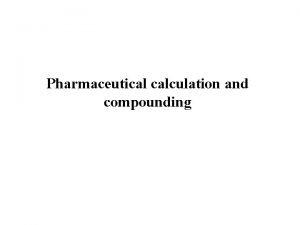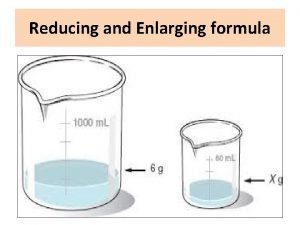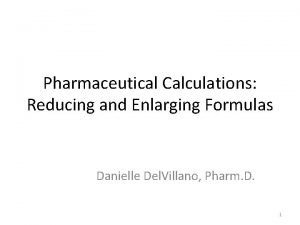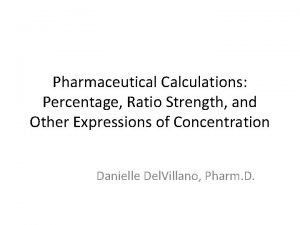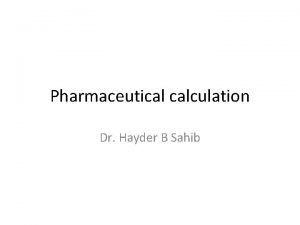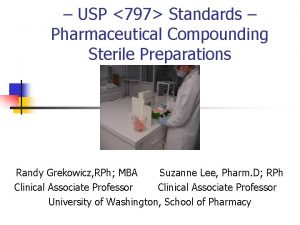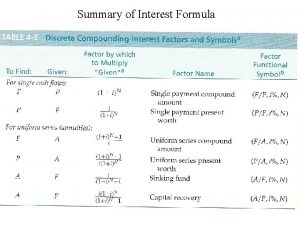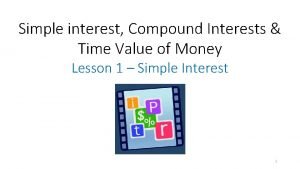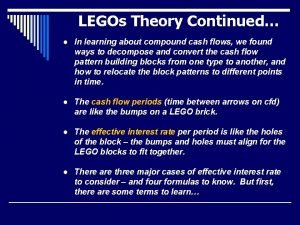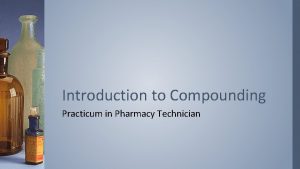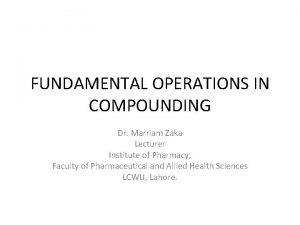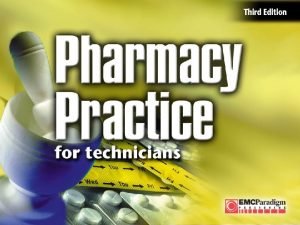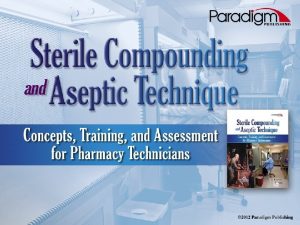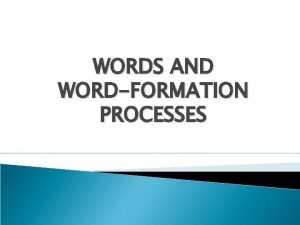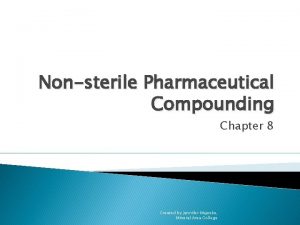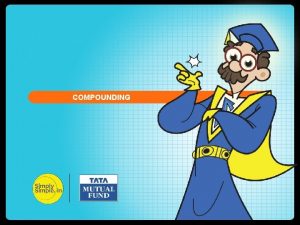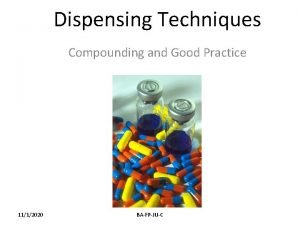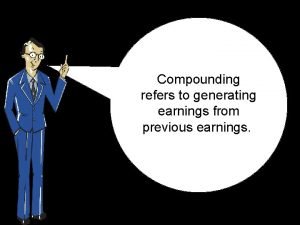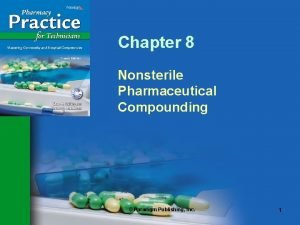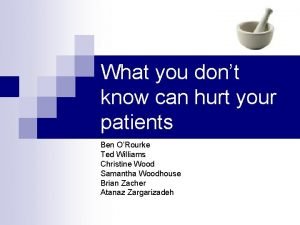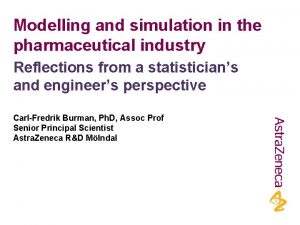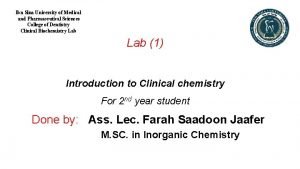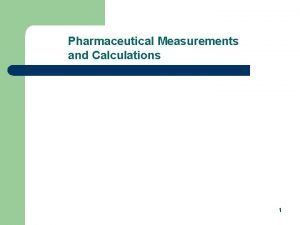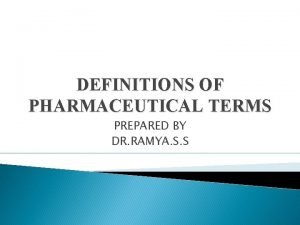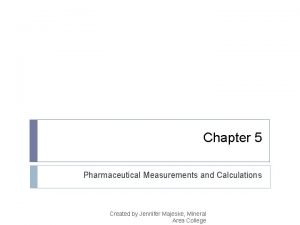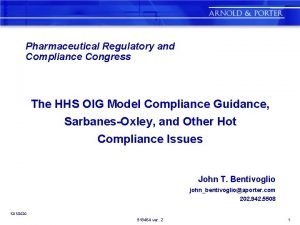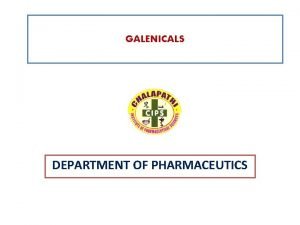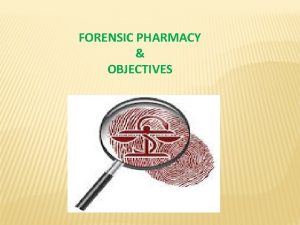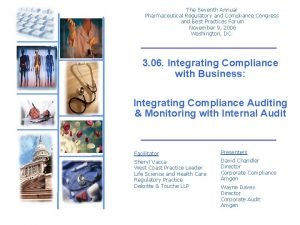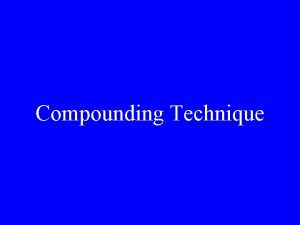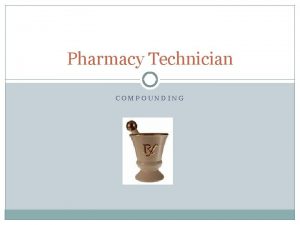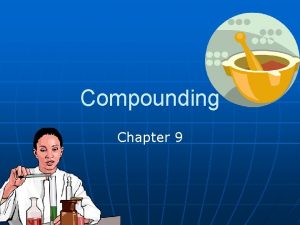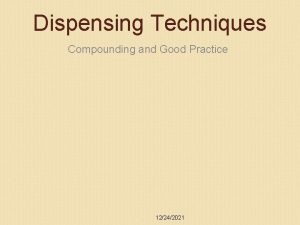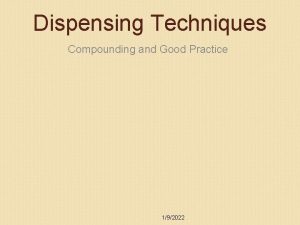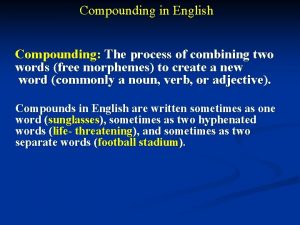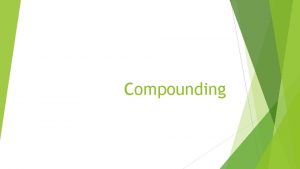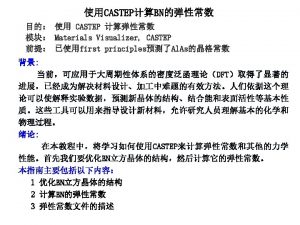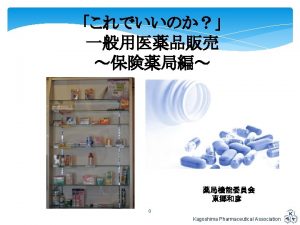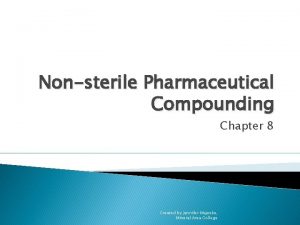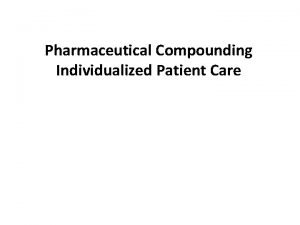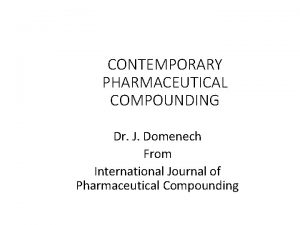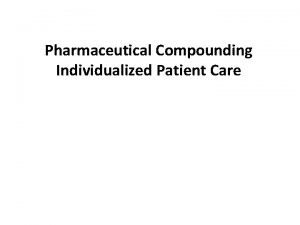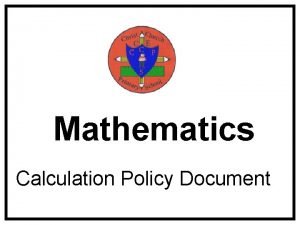Pharmaceutical calculation and compounding Pharmaceutical calculation and compounding














































- Slides: 46

Pharmaceutical calculation and compounding

Pharmaceutical calculation and compounding Course Title: Pharmaceutical calculation and compounding Course Number: 1701334 College: Pharmacy Credit Hours: 1 Department: Pharmaceutics Pre-requisite: 1701233 Semester & Academic Year: Summer 2018 -2019 Instructor: Dr. Rawan Karaki Course Level : 3 nd year Office Hours: 2 the time of the lecture: Sunday, Tuesday 8: 00 -9: 00

Required Textbook Howard C. Ansel and Shelly J. Stockton Pharmaceutical Calculations. 15 th ed.



Course Objectives This course provides a pharmacy student a basic foundation of calculations applicable to pharmacy practice. It gives a pharmacy student; skills in handling calculations concerning concentration expressions, density and specific gravity, reducing and enlarging formula, isotonicity, buffers and reaction kinetics. It provides a pharmacy student; skills in handling medicinal prescription and its appropriate calculations.

Scope of Pharmaceutical Calculations v chemical and physical properties of drug substances and pharmaceutical ingredients; v biological activity and rates of drug absorption, body distribution, metabolism and excretion (pharmacokinetics); v statistical data from basic research and clinical drug studies; v pharmaceutical product development and formulation; v prescriptions and medication orders including drug dosage, dosage regimens, and patient compliance; v pharmacoeconomics; and other areas.

Pharmaceutical Calculations The use of calculations in pharmacy is varied and broad-based. It encompasses calculations performed by pharmacists in traditional as well as in specialized practice settings and within operational and research areas in industry, academia, and government. In the broad context

Success in performing pharmaceutical calculations is based on: • an understanding of the purpose or goal of the problem; • an assessment of the arithmetic process required to reach the goal; and, • implementation of the correct arithmetic manipulations.

The following steps are suggested in addressing the calculation problems in this textbook as well as those encountered in pharmacy practice. STEP 1. • Take the time necessary to carefully read and thoughtfully consider the problem prior to engaging in computations. An understanding of the purpose or goal of the problem and the types of calculations that are required will provide the needed direction and confidence.

STEP 2. • Estimate the dimension of the answer in both quantity and units of measure (e. g. , milligrams) to satisfy the requirements of the problem. A section in Chapter 1 provides techniques for estimation. STEP 3. • Perform the necessary calculations using the appropriate method both for efficiency and understanding. For some, this might require a stepwise approach, whereas others may be capable of combining several arithmetic steps into one. Mathematical equations should be used only after the underlying principles of the equation are understood.

STEP 4. • Before assuming that an answer is correct, the problem should be read again and all calculations checked. In pharmacy practice, pharmacists are encouraged to have a professional colleague check all calculations prior to completing and dispensing a prescription or medication order. Further, if the process involves components to be weighed or measured, these procedures should be double-checked as well. STEP 5. • Finally, consider the reasonableness of the answer in terms of the numerical value, including the proper position of a decimal point, and the units of measure.

1. Fundamentals of Pharmaceutical Calculations OBJECTIVES Ø Demonstrate the use of percent in pharmaceutical calculations. Ø Apply the method of ratio and proportion in problem solving. Ø Apply the method of dimensional analysis in problem solving. Ø Demonstrate an understanding of significant figures. Ø Apply and validate the method of estimation in pharmaceutical calculations


Basic Mathematics

(Percentages) The term percent and its corresponding sign, %, mean ‘‘in a hundred. ’’ So, 50 percent (50%) means 50 parts in each one hundred of the same item. Example: Convert 3⁄8 to percent. Convert 0. 125 to percent. Converting percentages to fractions Example: 25%=25/100=1/4

1. Percent: (a)define the concentration or strength of a pharmaceutical preparation (e. g. , a 10% ointment) (b)describe the accuracy of a method or procedure (e. g. , a 5% error in a measurement or weighing), and (c)quantify a parameter in a clinical study (e. g. , 15% of subjects exhibited a particular effect). Example: During a clinical study involving 2430 subjects, 2% of the subjects developed a headache. How many patients experienced this adverse effect? 2% may be converted to a ratio or decimal fraction (e. g. , 2% = 2/100 = 0. 02). 2430 × 2% = 48. 6 or 48 patients, or, 2430 × 2/100 = 48. 6 or 48 patients, or, 2430 × 0. 02 = 48. 6 or 48 patients.

Converting fractions to percentages § Write the fraction in decimal form. (3/4=0. 75) § Write the decimal over one. (0. 75/1) § Multiply the numerator and denominator by 100. (0. 75/1 = 75/100) § Because you already know the “divided by a hundred” is the same as percent you can write 75/100 as 75%.


A vial of drug contains 40 mg/2 ml. How many milliliters (ml) are required to obtain 300 mg of drug? 1. 40 mg = 300 mg 2 ml X 2. (40 mg)(X)= (2 ml)(300 mg) 3. X = (2 ml)(300 mg) (40 mg) 4. X=15 ml

Example: If 3 tablets contain 975 milligrams of aspirin, how many milligrams should be contained in 12 tablets? If 3 tablets contain 975 milligrams of aspirin, how many tablets should contain 3900 milligrams

3. Dimensional analysis (also known as factor analysis, factor -label method, or unit-factor method) Example: A medication order calls for 1000 milliliters of a dextrose intravenous infusion to be administered over an 8 -hour period. Using an intravenous administration set that delivers 10 drops/milliliter, how many drops per minute should be delivered to the patient?

CASE IN POINT 1. 1 A pharmacist consults with a parent on the use of a cough syrup for her 5 -yearold child. The nonprescription cough syrup contains, in each 5 m. L (milliliters), 10 mg (milligrams) of dextromethorphan HBr, a cough suppressant, and 100 mg of guaifenesin, an expectorant. The package label indicates that the dose for a child 2 to 6 years of age is 1/4 of the adult dose of two teaspoonfuls. The pharmacist suggests using an oral syringe calibrated in 0. 25 -m. L units for dosing. If a standard teaspoonful is equivalent to 5 m. L, (a) how many milliliters should be administered to the child, and (b) how many milligrams of each of the two therapeutic ingredients would be administered per child's dose?

PRACTICE PROBLEMS 1. If an insulin injection contains 100 units of insulin in each milliliter, how many milliliters should be injected to receive 40 units of insulin? 2. Each tablet of TYLENOL WITH CODEINE contains 30 mg of codeine phosphate and 300 mg of acetaminophen. By taking 2 tablets daily for a week, how many milligrams of each drug would the patient take? 3. An oral solution contains, in each milliliter, 80 mg of lopinavir and 20 mg of ritonavir. How many milligrams of each drug would be contained in a calculated dose of 0. 4 m. L? 4. An elixir contains 25 mg of drug in each 5 m. L. How many milligrams of the drug would be used in preparing 4000 m. L of the elixir? 5. A 15 -m. L package of nasal spray delivers 20 sprays per milliliter of solution, with each spray containing 1. 5 mg of drug. (a) How many total sprays will the package deliver? (b) How many milligrams of drug are contained in the 15 -m. L package of the spray? 6. The dosage of the drug thiabendazole (MINTEZOL) is determined in direct proportion to a patient's weight. If the dose of the drug for a patient weighing 150 pounds is 1. 5 grams, what would be the dose for a patient weighing 110 pounds?

Units of Measure (Metric System) The International System of Units (SI), formerly called the metric system, is the internationally recognized decimal system of weights and measures. (Meter, Liter, Kilogram) The metric system is based on the decimal system, in which everything is measured in multiples or fractions of 10. Standard measures Meter; Length Gram; Weight Liter; Volume Prefixes kilo-; 1000 milli-; 1/1000 = 0. 001 micro-; 1/1000000 = 0. 000001

(Other Systems) • Avoirdupois – used in measuring bulk medications (pounds, ounces, grains) • Apothecary – developed after the Avoirdupois system to enable fine weighing of medications (pounds, ounces, drams, scruples, grains, gallons, pints, fluid ounces, fluid drams, minims) • Household – commonly used to measure liquids with home utensils (teaspoons, tablespoons, cups, pints, quarts)



Guidelines for the Correct Use of the SI The following are select guidelines for the correct use of the SI from the U. S. Metric Association, with additional considerations relevant to the practice of pharmacy: 1. • Unit names and symbols generally are not capitalized except when used at the beginning of a sentence or in headings. However, the symbol for liter (L) may be capitalized or not. Examples: 4 L or 4 l, 4 mm, and 4 g; not 4 Mm and 4 G. 2. • In the United States, the decimal marker (or decimal point) is placed on the line with the denomination and denominate number; however, in some countries, a comma or a raised dot is used. Examples: 4. 5 m. L (U. S. ); 4, 5 m. L or 4. 5 m. L (non-U. S. ). 3. • Periods are not used following SI symbols except at the end of a sentence. Examples: 4 m. L and 4 g, not 4 m. L. and 4 g. 4. • A compound unit that is a ratio or quotient of two units is indicated by a solidus (/) or a negative exponent. Examples: 5 m. L/h or 5 m. Lh 1, not 5 m. L per hour. 5. • Symbols should not be combined with spelled-out terms in the same expression. Examples: 3 mg/m. L, not 3 mg/milliliter.

Guidelines ……. . cont, 1. Plurals of unit names, when spelled out, have an added s. Symbols for units, however, are the same in singular and plural. Examples: 5 milliliters or 5 m. L, not 5 m. Ls. 2. • Two symbols exist for microgram: mcg (often used in pharmacy practice) and mg (SI). 3. • The symbol for square meter is m 2; for cubic centimeter, cm 3; and so forth. In pharmacy practice, cm 3 is considered equivalent to milliliter. The symbol cc, for cubic centimeter, is not an accepted SI symbol. 4. • Decimal fractions are used, not common fractions. Examples: 5. 25 g, not 51⁄4 g. 5. • A zero should be placed in front of a leading decimal point to prevent medication errors caused by uncertain decimal points. Example: 0. 5 g, not. 5 g. It is critically important for pharmacists to recognize that a misplaced or misread decimal point can lead to an error in calculation or in dispensing of a minimum of one tenth or ten times the desired quantity.

Guidelines ……. . cont, • To prevent misreading's and medication errors, ‘‘trailing’’ zeros should not be placed following a whole number on prescriptions and medication orders. Example: 5 mg, not 5. 0 mg. However, in some tables , pharmaceutical formulas, and quantitative results, trailing zeros often are used to indicate exactness to a specific number of decimal places. • In selecting symbols of unit dimensions, the choice generally is based on selecting the unit that will result in a numeric value between 1 and 1000. Examples: 500 g, rather than 0. 5 kg; 1. 96 kg, rather than 1960 g; and 750 m. L, rather than 0. 75 L.

(Equivalencies) Equivalencies among systems 1 inch = 2. 54 cm 1 kg = 2. 2 pounds (lb) 1 fluid ounce (fl oz) = 29. 57(30) milliliters (ml) 1 pint (pt) = 473. 167 (480) milliliters (ml) 1 teaspoonful (tsp) = 5 milliliters (ml) 1 tablespoonful (TBS) = 15 milliliters (ml) 1 ounce (oz) = 28. 35 grams (g) 1 pound (lb) = 453. 59 (454) grams (g)


Fill in the blanks: 1 liter (L) = ____ml 1000 g = _____kg 1 g = _______mg 1000 mcg =_____mg 1 TBS = ______tsp 1 TBS =_______ml 2 fl oz =_______ml 70 kg = _______pounds (lb)


Concentration and Dilution Terminology § 5% dextrose in water is the same as D 5 W. § 0. 9% sodium chloride (Na. Cl) is the same as normal saline (NS). § Half-normal saline is half the strength of normal saline (0. 9% Na. Cl), or 0. 45% Na. Cl. This may also be referred to as 1/2 NS

Concentration expressed as percentage § Percent weight-in-weight (w/w) is the grams of drug in 100 grams of the product. § Percent weight-in-volume (w/v) is the grams of drug in 100 ml of the product. § Percent volume-in-volume (v/v) is the milliliters of drug in 100 ml of the product.

• Example 1: – 0. 9% sodium chloride (w/v) = 0. 9 g of sodium chloride in 100 ml of solution. • Example 2: – 5% dextrose in water (w/v) = 5 g of dextrose in 100 ml of solution. • Example 3: – 23. 4% sodium chloride (w/v) = 23. 4 g of sodium chloride in 100 ml of solution.

Concentration and Dilution cont. • Example 4: – How many grams of dextrose are in 1 L of D 5 W? – Know ratio: D 5 W means 5 g 100 ml – Unknown ratio: X 1000 ml – Write the proportion and solve for X: X 5 g = 1000 ml 100 ml X = 50 g

Prescription Writing Style Using the SI • Prescriptions written in the SI use Arabic numerals before the abbreviations for the denominations (e. g. , 6 g). • Quantities of weight are usually written as grams and decimals of a gram, and volumes as milliliters and decimals of a milliliter.

Reducing SI Units to Lower or Higher Denominations by Ratio and Proportion or by Dimensional Analysis • Examples: Reduce 1. 23 kilograms to grams.


Volume is the amount of space occupied by a three-dimensional object as measured in cubic units (as milliliters or liters) L = Liter ml = milliliter 1 Liter = 1000 milliliters 3. 5 L = 3500 ml

Mass is a property of physical objects which measures the amount of matter in an object. kg = kilograms g = gram mg = milligram mcg = microgram ng = nanogram 1 kilogram = 1000 grams 1 gram = 1000 milligrams 1 milligram = 1000 micrograms 1 microgram = 1000 nanograms Example 0. 004 kg = 4000 mg = 4, 000 mcg

Density

Measurement of Volume
 Pharmacy compounding calculations
Pharmacy compounding calculations Reducing and enlarging formulas in pharmacy
Reducing and enlarging formulas in pharmacy Reducing and enlarging formulas examples
Reducing and enlarging formulas examples Percent strength
Percent strength Scope of pharmaceutical calculation
Scope of pharmaceutical calculation Low and medium risk sterile compounding quiz
Low and medium risk sterile compounding quiz Perbedaan discounting dan compounding
Perbedaan discounting dan compounding Compound monthly formula
Compound monthly formula Compounded daily formula
Compounded daily formula Sterile technique quiz
Sterile technique quiz Idaily semi
Idaily semi Tool that measures angles
Tool that measures angles Fundamental operations in compounding pdf
Fundamental operations in compounding pdf What is levigation in compounding
What is levigation in compounding Alligation calculator
Alligation calculator Compounding periods
Compounding periods What does compounding the brakes mean
What does compounding the brakes mean Non sterile preparation example
Non sterile preparation example 10 types of morphological processes
10 types of morphological processes Examples of extemporaneous compounding
Examples of extemporaneous compounding Examples of word formation
Examples of word formation Non sterile compounding equipment
Non sterile compounding equipment 3-6 continuous compounding answer key
3-6 continuous compounding answer key To prevent coring of a rubber stopper in vials
To prevent coring of a rubber stopper in vials Compounding refers to
Compounding refers to Monofilament extrusion line
Monofilament extrusion line Adelphi coldstream
Adelphi coldstream Compounding interest rate swap
Compounding interest rate swap Compounding refers to
Compounding refers to Compounding spatula
Compounding spatula Lloyd center compounding pharmacy
Lloyd center compounding pharmacy Spitbak
Spitbak Buss kneader technology
Buss kneader technology 3-6 continuous compounding
3-6 continuous compounding Pharmaceutical simulation and modeling
Pharmaceutical simulation and modeling Serum vs plasma
Serum vs plasma Brno university of veterinary and pharmaceutical sciences
Brno university of veterinary and pharmaceutical sciences Veterinary and pharmaceutical university brno
Veterinary and pharmaceutical university brno Pharmaceutical measurements and calculations
Pharmaceutical measurements and calculations Pharmacopedics
Pharmacopedics Pharmaceutical measurements
Pharmaceutical measurements Pharmaceutical regulatory and compliance congress
Pharmaceutical regulatory and compliance congress Galenical prepared by extraction
Galenical prepared by extraction Forensic pharmacy
Forensic pharmacy Mission and vision of pharmaceutical company
Mission and vision of pharmaceutical company Pharmaceutical regulatory and compliance congress
Pharmaceutical regulatory and compliance congress Pharmaceutical regulatory and compliance congress
Pharmaceutical regulatory and compliance congress
